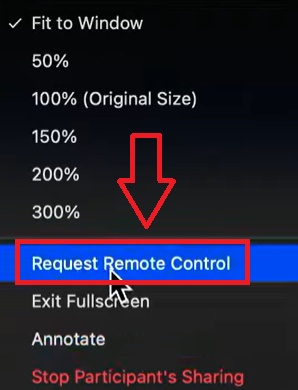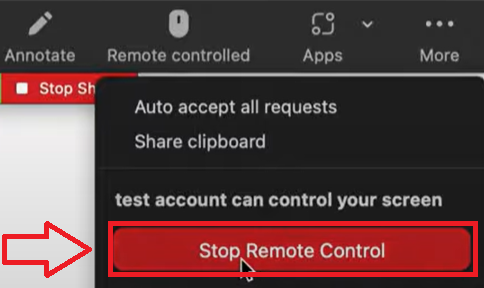Requesting Remote Control in Zoom: Simple How-To
August 28, 2024
August 28, 2024
June 12, 2025
June 12, 2025
Remote control in Zoom can be a game-changer for collaboration, technical support, and more. Whether you're troubleshooting a colleague's issue, guiding a team member through a task, or leading a training session, knowing how to request and start remote control effectively can make meetings more productive. This guide walks you through the steps to request remote control in Zoom.
To enhance your Zoom experience, explore Guide to Using Zoom Whiteboard for Collaboration and How Long Does Zoom Take to Process a Recording?
What is Remote Control in Zoom?
Remote control in Zoom allows one person to take control of another participant's computer during a meeting. This feature can help with technical support, collaboration, and more. Using remote control, you can manage someone else's screen, making it easier to show them how to do something or fix an issue directly.
Zoom Settings Required for Enabling Remote Support:
- Sign In: Log in to the Zoom web portal as an admin.
- Navigate to Settings: Go to the "Settings" tab on the left.
- Meeting Tab: Select the "Meeting" tab at the top.
- Enable Remote Control: Scroll to the "In Meeting (Basic)" section and click "Remote control" to turn on.

- Save Changes: Ensure you save the settings to apply them.
Remote control in Zoom is a powerful feature that can enhance your meetings, making them more interactive and productive.
How to Request Remote Control in Zoom
- Share Screen: First, the person whose screen you want to control must share their screen. They can do this by clicking the "Share Screen" button in the Zoom toolbar.
- View Options: At the top of your Zoom window, click on the "View Options" dropdown menu.
- Request Remote Control: Select "Request Remote Control" from the dropdown menu, then click "Request" in the pop-up window.

- Approval: The participant will receive a notification asking if they want to allow you to control their screen. They must click "Approve."
- Control: Once approved, click inside the screen share to start controlling the participant's screen.
How to Respond to a Remote Control Request
- Notification: When someone requests control of your screen, a notification will pop up.
- Approve or Decline: You will see options to "Approve" or "Decline" the request. If you trust the person and want them to take control, click "Approve."
- End Control: To end the remote control session, you can click "View Options" and select "Give Up Remote Control."
Troubleshooting Common Issues When Requesting Remote Control
- Permission Denied: If the request is not approved, ensure the person understands how to approve it.
- No Response: If the participant doesn't see the request, ask them to check for the notification.
- Technical Glitches: Sometimes, technical issues can occur. Restart Zoom and try again if you face any glitches.
- Compatibility Issues: Ensure both participants are using compatible Zoom versions. Remote control may not work on older versions.
Best Practices for Requesting and Using Remote Control
- Ask First: Always ask the participant if you can request control before sending a request.
- Clear Communication: Explain why you need control and what you will do.
- Respect Privacy: Only access necessary files or applications. Respect the participant's privacy.
- End Gracefully: Once done, inform the participant and properly end the session by relinquishing control.
Remote control in Zoom can simplify many tasks, from troubleshooting to collaborative work. Following these steps and best practices ensures a smooth and respectful experience for all participants.
How to Grant Remote Control in Zoom
- Start Screen Sharing: Begin by sharing your screen. Click the "Share Screen" button in the Zoom toolbar.
- Remote Control Option: While sharing your screen, click on the "Remote Control" option in the toolbar.

- Select Participant: Choose the participant to whom you want to grant control from the dropdown list.
- Notification: The selected participant will receive a notification that they can now control your screen.
- Begin Control: The participant can start controlling your screen by clicking anywhere on the shared screen.
Managing Permissions for Remote Control
- Initial Set-Up: Ensure that remote control is enabled in your Zoom settings. Go to the Zoom web portal, click "Settings," and under the "Meeting" tab, enable "Remote Control."
- Permissions: When granting control, keep in mind that the participant will have access to your mouse and keyboard. Only grant control to trusted individuals.
- Temporary Access: Remote control access is temporary and only lasts for the duration of the screen-sharing session.
How to Revoke Remote Control Access
- View Options: While sharing your screen, click on the "View Options" dropdown menu.
- Give Up Control: Select "Give Up Remote Control" to revoke the participant's access.
- Confirmation: The participant will lose control immediately, and you will regain full control of your screen.
Security Tips When Granting Remote Control
- Verify Identity: Always verify the identity of the person you're granting control to. Ensure they are who they say they are.
- Sensitive Information: Avoid giving remote control access if sensitive information is displayed on your screen.
- Monitor Activity: Keep an eye on what the participant is doing while they have control. Intervene if they access unauthorized areas.
- End Session Properly: After the session, ensure you properly stop remote control by selecting "Stop Remote Control."

Monitoring and Managing Remote Control Sessions
- Active Monitoring: Actively monitor the session while someone has control. This helps ensure they are only performing the tasks discussed.
- Communication: Maintain open communication with the participant. Use Zoom's chat or voice features to guide them and provide feedback.
- Session Logs: After the session, review any activity logs available in Zoom to ensure no unauthorized actions were taken.
- Post-Session Review: Discuss with the participant what was accomplished during the remote control session and review any follow-up actions needed.
Granting remote control in Zoom can be an efficient way to collaborate and troubleshoot. However, managing permissions and monitoring activity are crucial to maintaining security and ensuring a smooth experience. Always follow best practices to keep your sessions safe and productive.
How to Use Remote Control Features Effectively
Navigating the Remote Control Toolbar in Zoom
Understanding the Toolbar: When you control someone else's screen, a new toolbar appears at the top of your screen. This toolbar includes options like "Stop Share," "Annotate," and "Remote Control."
- Stop Share: Ends the screen-sharing session.
- Annotate: Opens tools like text, shapes, and drawing.
- Remote Control: Allows you to give or take control of the screen.
Switching Between Tools: Easily switch between these tools using your mouse or keyboard shortcuts. This flexibility helps you manage the session without interrupting the flow of work.
Sharing Files and Applications While in Remote Control Mode
File Sharing: Use Zoom's built-in file sharing to send documents, images, or other files during the session.
- Click "Chat": Open the chat window.
- Click "File": Choose the file you want to share from your computer or cloud storage.
Application Sharing: When controlling someone’s screen, you can also access and operate applications on their computer.
- Start Application: Open any application you need.
- Operate Normally: Use the application as if you were on your own computer, making changes or demonstrating features.
Communicating Effectively with the Remote Controller
Open Communication Channels: Use Zoom's chat or voice communication tools to stay in constant contact. This ensures both parties are on the same page.
- Chat: Type messages for quick, written communication.
- Voice: Speak directly using Zoom’s audio feature for more detailed explanations.
Clear Instructions: Give clear, step-by-step instructions when guiding the other person. This helps avoid confusion and keeps the session focused.
Ending a Remote Support Session Properly
Giving Up Control: When you’re done, click "View Options" and select "Give Up Remote Control." This immediately returns control to the original remote-controlling user.
Summary of Actions: Briefly summarize what was done during the session. This helps ensure both parties understand what was accomplished.
Confirm Completion: Ask the other person if they need anything else before ending the session. This ensures no steps were missed and all issues are resolved.
Proper Exit: Click "Stop Share" to end the screen-sharing session. Ensure both parties understand the session has concluded.
Using Zoom's remote control features effectively requires familiarity with the tools and clear communication. By navigating the toolbar, using annotations, sharing files, communicating clearly, and ending sessions properly, you can make the most out of remote support sessions.
Common Issues and How to Solve Them
Connection Problems During Remote Control Sessions
Issue: Sometimes, you might experience connection problems that interrupt your remote support session. This can be due to unstable internet connections or network issues.
Solutions:
- Check Internet Connection: Ensure both you and the person you're controlling have a stable internet connection. Use a wired connection if possible.
- Reconnect: If the session drops, try reconnecting by clicking "Leave Meeting" and then rejoining.
- Restart Zoom: Sometimes, restarting the Zoom application can resolve minor issues.
Handling Unresponsive Applications When Controlled Remotely
Issue: An application might freeze or become unresponsive when you control it remotely.
Solutions:
- End Task: Use Task Manager (Ctrl + Shift + Esc on Windows or Command + Option + Esc on Mac) to force quit the unresponsive application.
- Restart Application: After ending the task, restart the application to regain control.
- Communicate: Inform the person you're helping about the issue. They might need to restart their computer.
Dealing with Latency and Performance Issues
Issue: Latency can cause delays in your actions, making it difficult to control the remote screen smoothly.
Solutions:
- Lower Quality: Adjust screen-sharing settings to a lower resolution. Go to "Settings" > "Share Screen" > "Advanced" and select "Optimize for video clip."
- Close Background Apps: Ask the person you’re controlling to close any unnecessary applications that might be hogging bandwidth or processing power.
- Network Speed: Run a speed test to check internet speeds. If speeds are low, consider using a faster network or upgrading the internet plan.
Ensuring Compatibility with Different Operating Systems
Issue: Compatibility issues might arise when controlling a device with a different operating system.
Solutions:
- Update Software: Ensure both Zoom applications are updated to the latest version. Compatibility improves with the latest updates.
- Check Permissions: Different operating systems have different permission settings. Ensure the correct permissions are granted for remote control.
- Use Compatible Tools: Verify that the tools and applications you plan to use are compatible across both operating systems.
User Permissions and Access Restriction Errors
Issue: You might face issues with user permissions or access restrictions that prevent remote control.
Solutions:
- Check Settings: Ensure the necessary permissions are enabled in Zoom settings. Go to "Settings" > "Meeting" > "Remote Control" and make sure it's toggled on.
- Admin Controls: Sometimes, only an account administrator can change settings. Contact the admin if needed.
- Grant Permissions: Ensure the person you’re controlling grants you the necessary permissions during the session. They need to click "Approve" when prompted.
Best Practices:
- Communicate Clearly: Always inform the person you’re controlling about what you’re doing, especially when changing settings or permissions.
- Test in Advance: If possible, test the remote control session beforehand to identify and resolve any issues.
By addressing these common issues, you can ensure smoother and more effective remote control sessions in Zoom.
{{rt_cta_ai-convenience}}
Enhancing Your Zoom Meetings with Tactiq

Tactiq is a tool designed to enhance your Zoom meetings by providing real-time transcriptions, AI-generated summaries, and comprehensive meeting records. Here’s how it can improve your Zoom sessions:
- Real-Time Transcriptions for Accurate Record-Keeping
- Tactiq delivers live transcriptions of your Zoom meetings, capturing every word spoken with precision.
- This feature helps you stay on top of discussions, making it easier to follow complex topics and revisit details later.
- AI-Generated Summaries to Capture Key Insights
- Using AI, Tactiq creates summaries that distill the most important points from your meetings.
- These concise overviews save you time by highlighting key discussions, making preparation for follow-up meetings more efficient.
- Customized AI Prompts & Meeting Kits: Tactiq offers AI-driven prompts and meeting kits that assist in organizing follow-up tasks, such as drafting emails or creating project tickets, directly from your meeting notes, ensuring nothing falls through the cracks.
- Automated Post-Meeting Workflows: With Tactiq, you can automate the process of assigning tasks and distributing meeting summaries, minimizing manual effort and enhancing productivity.
By incorporating Tactiq into your Zoom meetings, you’ll ensure they are well-documented, efficient, and geared towards effective collaboration. Try Tactiq today and experience how it can transform your Zoom meetings into well-documented, streamlined sessions. Download Tactiq today to optimize your Zoom meetings.
Remote control in Zoom allows one person to take control of another participant's computer during a meeting. This feature can help with technical support, collaboration, and more. Using remote control, you can manage someone else's screen, making it easier to show them how to do something or fix an issue directly.
Share Screen: First, the person whose screen you want to control must share their screen. They can do this by clicking the "Share Screen" button in the Zoom toolbar. View Options: At the top of your Zoom window, click on the "View Options" dropdown menu. Request Remote Control: Select "Request Remote Control" from the dropdown menu, then click "Request" in the pop-up window. Approval: The participant will receive a notification asking if they want to allow you to control their screen. They must click "Approve." Control: Once approved, click inside the screen share to start controlling the participant's screen.
Notification: When someone requests control of your screen, a notification will pop up. Approve or Decline: You will see options to "Approve" or "Decline" the request. If you trust the person and want them to take control, click "Approve." End Control: To end the remote control session, you can click "View Options" and select "Give Up Remote Control."
Permission Denied: If the request is not approved, ensure the person understands how to approve it. No Response: If the participant doesn't see the request, ask them to check for the notification. Technical Glitches: Sometimes, technical issues can occur. Restart Zoom and try again if you face any glitches. Compatibility Issues: Ensure both participants are using compatible Zoom versions. Remote control may not work on older versions.
Ask First: Always ask the participant if you can request control before sending a request. Clear Communication: Explain why you need control and what you will do. Respect Privacy: Only access necessary files or applications. Respect the participant's privacy. End Gracefully: Once done, inform the participant and properly end the session by relinquishing control.
Want the convenience of AI summaries?
Try Tactiq for your upcoming meeting.
Want the convenience of AI summaries?
Try Tactiq for your upcoming meeting.
Want the convenience of AI summaries?
Try Tactiq for your upcoming meeting.









